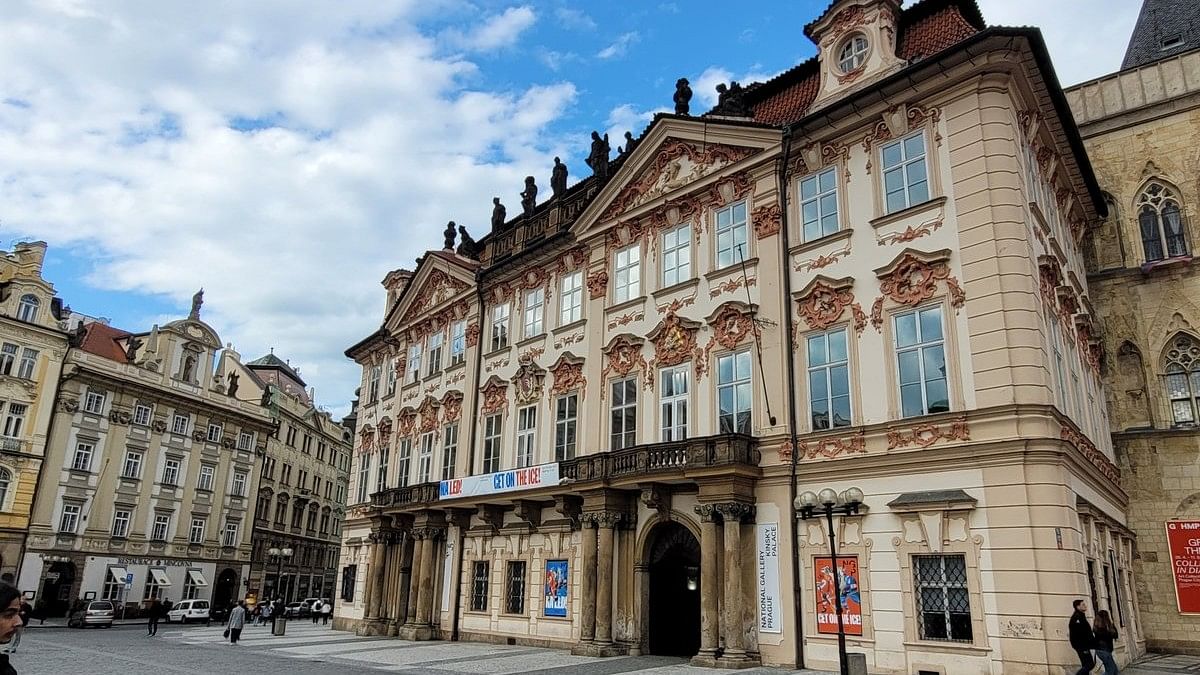
The Kinský Palace was once the home of a noble count but is now linked to some revered Czech writers like Kafka.
Credit: PHOTO BY AUTHOR
“Prague doesn’t let go. Of either of us. This old crone has claws. One has to yield, or else.” This is how German-speaking Bohemian Jewish novelist Franz Kafka described the city of his birth to his friend Oskar Pollak. Kafka spent most of his life in Prague and died on June 3, 1924 at a tuberculosis sanatorium outside Vienna. A week later, he was buried in the New Jewish Cemetery in Prague; the city indeed did not let him go.
While Kafka was virtually unknown during his lifetime, his posthumous fame has made him the most celebrated son of the city. So naturally, on my spring break in the Czech capital, I immersed myself in his world, beginning with a visit to his birthplace. Kafka was born on July 3, 1883 in what was called the ‘Tower House’ close to the Old Town Square. The building was torn down during mass demolition of old houses in the 19th and 20th centuries; only the original baroque stone portal remains. A commemorative bust and plaque were added later and, in 2000, the area was renamed Franz Kafka Square. Later that evening, on a walking tour of the Old Town, my guide points out a few other Kafka sites. A couple of steps from the Astronomical Clock Tower stands ‘U Minuty’ (The Minute House) where the Kafka family lived in a first-floor flat from 1889 to 1896. The late Gothic building is decorated with eye-catching 16th-century Renaissance sgraffito.
A short walk away, in the Old Town Square, is Kinský Palace with a stunning pink-and-white rococo façade adorned with ornate stucco work. Once the home of a noble count, it is now part of the National Gallery of Prague and hosts temporary exhibitions. Kafka’s father was a haberdasher and he had his store on the ground floor of the palace. From 1893 to 1901, Kafka attended a German school based in the back part of the palace. In the Jewish Quarter, we pause between the Moorish-style Spanish Synagogue and the Gothic Church of the Holy Spirit to admire a bronze statue by Jaroslav Róna installed in 2003. It shows a suit-clad
Kafka riding on the shoulders of a gigantic headless man, a reference to his 1912 story Description of a Struggle. The guide draws my attention to the tiled ground below depicting a many-legged insect, perhaps a nod to Metamorphosis. Another artistic tribute is the ‘Head of Franz Kafka’ by David Cerný located behind the Quadron Shopping Centre in New Town. The gigantic bust comprises 42 steel panels rotating in different directions, symbolising Kafka’s complex mind.
The next morning, I visit the Franz Kafka Museum in Lesser Town across the Vltava River. Opened in 2005, the museum is divided into two sections — ‘Existential Space’ and ‘Imaginary Topography’. The former presents the way Prague shaped Kafka’s life and his work, all showcased through his extensive diaries and correspondence with family members, friends, lovers, and publishers. The latter section explores how he depicts the city in his writing, often without naming the places that inspired him. Kafka’s complicated relationship with his father unfolds through a letter written in 1919, an over-the-top diatribe laying bare all his inner conflicts. Elsewhere, he writes about his childhood memories, like the short walk from home (The Minute House) to school (at Kinský Palace), the very path I trod the previous day. Kafka describes in detail the horror of this path, the dread of classes, and the threatening cook — “short and thin, sharp-nosed and hollow-cheeked” — who accompanied him.
Kafka worked as a clerk at the Worker’s Accident Insurance Company, where he reported on industrial accidents. He often complained about the difficulties of balancing his job and his writing. In a letter to his one-time fiancée Felice Bauer, he writes: “Writing and office cannot be reconciled, since writing has its centre of gravity in depth, whereas the office is on the surface of life.”
The building is now the Hotel Century Old Town where you can actually rent the Kafka Suite, which was once his office.
Another fantastic exhibition is at the DOX Contemporary Art Gallery. Titled ‘KAFKAesque’ (until September 22, 2024), it presents works by more than 30 international artists reflecting on Kafka’s life and works through paintings, installations, and multimedia art. On my last morning in Prague, I head to one of Kafka’s old haunts.
With its marble walls, staircase, and convivial setting, Café Louvre was the hub for Prague’s writers, artists, and intelligentsia; even Albert Einstein frequented it when he worked at the German University of Prague from 1911 to 1912.
I miss paying my respects at Kafka’s grave this time around. But that just means I will have to return to Prague — just as he said, the old crone now has her claws in me too!